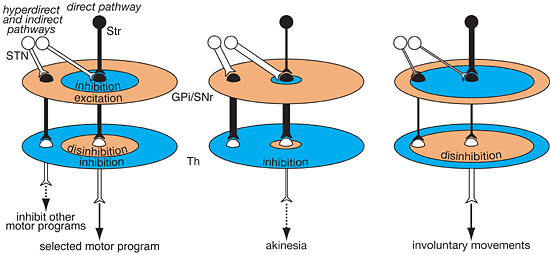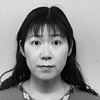DEPARTMENT OF INTEGRATIVE PHYSIOLOGY
We investigate human brain functions non-invasively mainly using magnetoencephalography (MEG) and electroencephalography (EEG), but recently we have also used functional magnetic resonance imaging (fMRI), transcranial magnetic stimulation (TMS) and near infrared spectroscopy (NIRS). Integrative studies using various methods are necessary to understand the advantages and disadvantages of each method. The following investigations are in progress at present.
(1) Sensory system: By recording brain responses to visual, auditory, somatosensory or pain stimuli, the organization of sensory processing in the human brain is being investigated. In particular, our interest is focused on the underlying mechanisms of two-point discrimination, interaction and correlation between somatosensory and motor function, pain perception and visual motion perception.
(2) Even-related brain responses: Using various psychophysical tasks or paradigms, we are investigating cognitive processing of the brain (higher brain functions). In particular, our interest is focused on the underlying mechanisms of face perception, inhibition processing using Go-NoGo paradigm, and masking phenomenon using repetitive stimuli.
(3) Application of brain research to education and society: Recently we focused on the development of brain function in infants and children. EEG and NIRS are useful in this study, since these methods can be applied to infants and children who can not hold their heads still for a long time.
306-channel helmet-shaped MEG recording system (ELEKTA-Neuromag, Finland)
Cortical processing of sensory information traced by MEG.
Cortical activations induced by tactile, auditory, visual and noxious stimuli. In all the sensory modalities, several cortical areas are activated serially with a time delay of 4-5 ms, which is consistent with a hierarchical processing of sensory information.
Staff
 |
Professor:
KAKIGI, Ryusuke, MD, PhD
1978 Graduated from Kyusyu University, Faculty of Medicine. 1981 Clinical Associate, Department of Internal Medicine, Saga Medical School. 1983-1985 Research Fellow, The National Hospital for Nervous Diseases, University of London. 1992 Assistant Professor, Department of Internal Medicine Saga Medical School. 1993 Professor, NIPS.
Speciality: Neurophysiology |
 |
Associate Professor:
KANEOKE, Yoshiki, MD, PhD
1984 Graduated from Nagoya University, Faculty of Medicine. 1992 Completed the doctoral course in Neurology, Nagoya University, 1992-1995 Research Fellow & Assistant Professor, Department of Neurology, Emory University, U.S.A. 1995 Associate Professor, NIPS.
Speciality: Neurology, Neurophysiology |
 |
Assistant Professor:
INUI, Koji, MD, PhD
1989 Graduated from Saga Medical School, Faculty of Medicine. 1994 Completed the doctoral course in Psychiatry, Mie University. 1994 Assistant Professor, Department of Psychiatry, Mie Univertsity. 2000 Research fellow, 2001 Assistant Professor, NIPS.
Speciality: Neurophysiology, Psychiatry |
 |
Assistant Professor:
MIKI, Kensaku, MD, PhD
2000 Graduated form Hamamatsu university school of medicine, 2004 Completed doctoral course in Life Science, the GraduateUniversity of Advanced Studies. 2004 JSPS Research Fellow. 2008 Assistant Professor, NIPS.
Speciality: Neurophysiology |
 |
JSPS Postdoctoral Fellow:
KIDA, Tetsuo, PhD
2000 Graduated from School of Health and Physical Education, University of Tsukuba, 2004 Completed the doctoral course in Health and Sports Sciences, University of Tsukuba, 2005 Research Fellow, NIPS.
Speciality: Exercise Physiology, Neurophysiology |
 |
Research Fellow:
HASHIMOTO, Akiko , PhD
1975 Graduated from University of Rikkyo. 1998 Completed the master course in Behavioral Sciences, University of Shinshu. 2004 Completed the doctoral course in Shinshu University Graduate School of Medicine.
Speciality: Social preventive medicine, Cognitive psychology, Clinical psychology |
 |
JSPS Postdoctoral Fellow:
HIRAI, Masahiro, PhD
2005 Completed the doctoral course in Graduate School of Arts and Sciences, the University of Tokyo. 2005-2006 Postdoctoral Fellow, 21st century program center for evolutionary cognitive sciences at the University of Tokyo. 2006- JSPS Research Fellow.
Speciality: Developmental cognitive neuroscience, Social cognitive neuroscience |
 |
JST Postdoctoral Fellow:
HONDA, Yukiko, PhD
2002 Graduated from Aichi Syukutoku University, Faculty of Literature. 2004 Completed the master course in Psychology, Aichi Syukutoku University. 2007 Completed the doctoral course in Life Science, the Graduate University for Advanced Studies.
Speciality: Neurophysiology, Developmental Psychology |
 |
Postdoctoral Fellow:
MOCHIZUKI, Hideki, PhD
2004 Completed the doctoral course in Tohoku University Graduate School of Medicine. 2004-2007 Postdoctral Fellow, Institute of Neuroscience NCNP. 2007- JFNM Research resident.
Specialty: Neurophysiology, Neuropharmacology |
 |
JST Postdoctoral Fellow:
TANAKA, Emi, PhD
2002 Graduated from Faculty of Letters, Nara Woman University. 2004 Completed the Masterís Course in Human Behavioral Science, Nara Woman University. 2007 Completed the Doctoral Course in Life Science, The Graduate University for Advanced Studies. 2007 JST Research Fellow.
Speciality: Visual Neuroscience, Human behavioral science |
Living animals, including human beings, obtain many pieces of information from the external and internal environments, integrate them to make a decision for appropriate behavioral activity, and finally take action based on self-intension. The brain areas, such as the cerebral cortex, basal ganglia and cerebellum, play a major role in the voluntary movements. On the other hand, malfunctions of these structures result in movement disorders, such as Parkinsonís disease. The major goal of our research programs is to elucidate the mechanisms underlying higher motor functions and the pathophysiology of movement disorders. To explore such intricate brain functions, we employ a wide range of neurophysiological and neuroanatomical techniques.
The current topics under study are as follows: 1) Elucidation of information flows through the neuronal networks by electrophysiological and anatomical methods; 2) Understanding the mechanism how the brain controls voluntary movements by electrophysiological recordings of neuronal activity from animals performing motor tasks, combined with local injection of neuronal blockers; 3) Elucidation of the pathophysiology of movement disorders by recording neuronal activity from animal models; 4) Understanding the pathophysiology of movement disorders by analyzing neuronal activity recorded in human patients during stereotaxic surgery.

Schematic model explaining functions of the basal ganglia and pathophysiology of movement disorders. The hyperdirect, direct and indirect pathways control the activity of the thalamus (Th), and relaease only the selected motor program at the appropriate timing (left). In hypokinetic disorders such as Parkinsonís disease (center), reduced disinhibition in the thalamus through the direct pathway results in akinesia. On the other hand, reduced activity in the GPi/SNr induces excessive disinhibition on the thalamus and results in involuntary movements in hyperkinetic disorders such as dystonia (right).
Wriggle Mouse Sagami, one of the models of movement disorders.
Staff
 |
Professor:
NAMBU, Atsushi, MD, PhD
1982 Graduated from Kyoto University, Faculty of Medicine. 1985 Research Associate, Kyoto University, School of Medicine. 1989 Postdoctoral Fellow, New York University, Faculty of Medicine. 1991 Associate Professor, NIPS. 1995 Director, Tokyo Metropolitan Institute for Neuroscience. 2002 Professor, NIPS.
Speciality: Neurophysiology |
 |
Assistant Professor:
HATANAKA, Nobuhiko, DDS, PhD
1996 Graduated from Ohu University, Faculty of Dentistry. 1996 Resident at Ohu University Hospital. 1997 Research Associate, Ohu University, Faculty of Dentistry. 1998 Research Fellow, Tokyo Metropolitan Institute for Neuroscience. 2003 Assistant Professor, NIPS.
Speciality: Neurophysiology, Neuroanatomy |
 |
Assistant Professor:
TACHIBANA, Yoshihisa, DDS, PhD
1999 Graduated from Osaka University, Faculty of Dentistry. 2003 Completed the doctoral course in Dental Sciences, Graduate School of Osaka University. 2003 Research Fellow, NIPS. 2003 Assistant Professor, NIPS.
Speciality: Neurophysiology |
 |
Assistant Professor:
CHIKEN, Satomi, PhD
1994 Graduated from Tokyo Metropolitan University, Department of Biological Sciences.1999 Completed the doctoral course in Biological Sciences, Graduate School of Tokyo Metropolitan University. 2000 Research Fellow, Tokyo Metropolitan Institute for Neuroscience. 2002 Research Fellow, Japan Society for the Promotion of Science. 2006 Assistant Professor, NIPS.
Speciality: Neurophysiology, Neurobiology |
 |
Postdoctoral Fellow:
SANO, Hiromi, PhD
1997 Graduated from Kyoto Pharmaceutical University. 1999 Completed the master course in Graduate School of Biological Science, Nara Institute of Science and Technology. 2003 Completed the doctoral course in Graduate School of Biological Science, Nara Institute of Science and Technology. 2003 Research Associate, Fukushima Medical University. 2004 Research Associate, Kyoto University, Graduate School of Medicine. 2007 Postdoctoral Fellow, NIPS.
Speciality: Molecular neurobiology |
 |
Postdoctoral Fellow:
TAKARA, Sayuki, PhD
2003 Graduated from Kyushu Institute of Technology. 2005 Graduated from the master course in Department of Brain Science and Engineering, Kyushu Institute of Technology.2008 Completed the doctoral course in Life Science, the Graduate University for Advanced Studies. 2008 Postdoctral Fellow, NIPS
Speciality: Molecular neurobiology |
Information-processing aspects of brain functions cannot be revealed simply by accumulating knowledge about brain loci or substances. Computational approaches are thus used to elucidate the mechanisms of how the brain works.
(1)The cerebellum was believed to be a neural organ for motor control. However, the recent studies have shown that it contributes tothe cognitive functions specific to humans. Handling tools and reading peopleís minds are one of these functions. We clarify the neural mechanisms behind the cognitive functions that include the cerebellum.
(2)Humans have a potential to adapt to different environments. They are proficient in controlling their movements and handling various tools. Our goal is to understand the learning and control mechanisms of our motor system and determine their neural substrates.
(3)Interpretation of massive neurobiological data requires solid computational frameworks. For neuroscience, we develop computational models and software tools for estimating signal sources from MEG data.
Stiffness elongated in an unstable direction
Staff
 |
Professor:
KAWATO, Mitsuo, PhD
1976 Graduated from Tokyo University, Faculty of Science. 1981 Completed the doctoral course in Engineering Science, Graduate School of Engineering Science, Osaka University. 1981 Research Associate and then Lecturer, Osaka University. 1988 Senior Researcher, ATR Auditory and Visual Perception Research Labs. 2003 Director of ATR Computational Neuroscience Labs., 2004 ATR Fellow.
Specialty: Computational Neuroscience |
 |
Associate Professor:
OSU, Rieko, PhD
1991 Graduated from Kyoto University, Faculty of Literature. 1997 Completed the doctoral course in Literature, Graduate School of Literature, Kyoto University. 1994 Intern student, ATR Human Information Processing Research Labs, 1996 Researcher, JST ERATO Project, 2003 Senior Researcher of ATR Computational Neuroscience Labs., 2004 Senior Research Scientist.
Specialty: Computational Neuroscience |
|